How Green’s went green
How one optician’s transformative journey started with a blank piece of (recycled) paper…
This is the story of Green’s Opticians and its recent journey towards becoming a more sustainable business. The story will take you through its project plan and highlight the initiatives it adopted to make transformative change and become a more eco-friendly, sustainable business and contribute to saving the world for future generations. For anyone thinking of embarking on this journey, the steps taken by Green’s may be of help.
Practice background and make-up
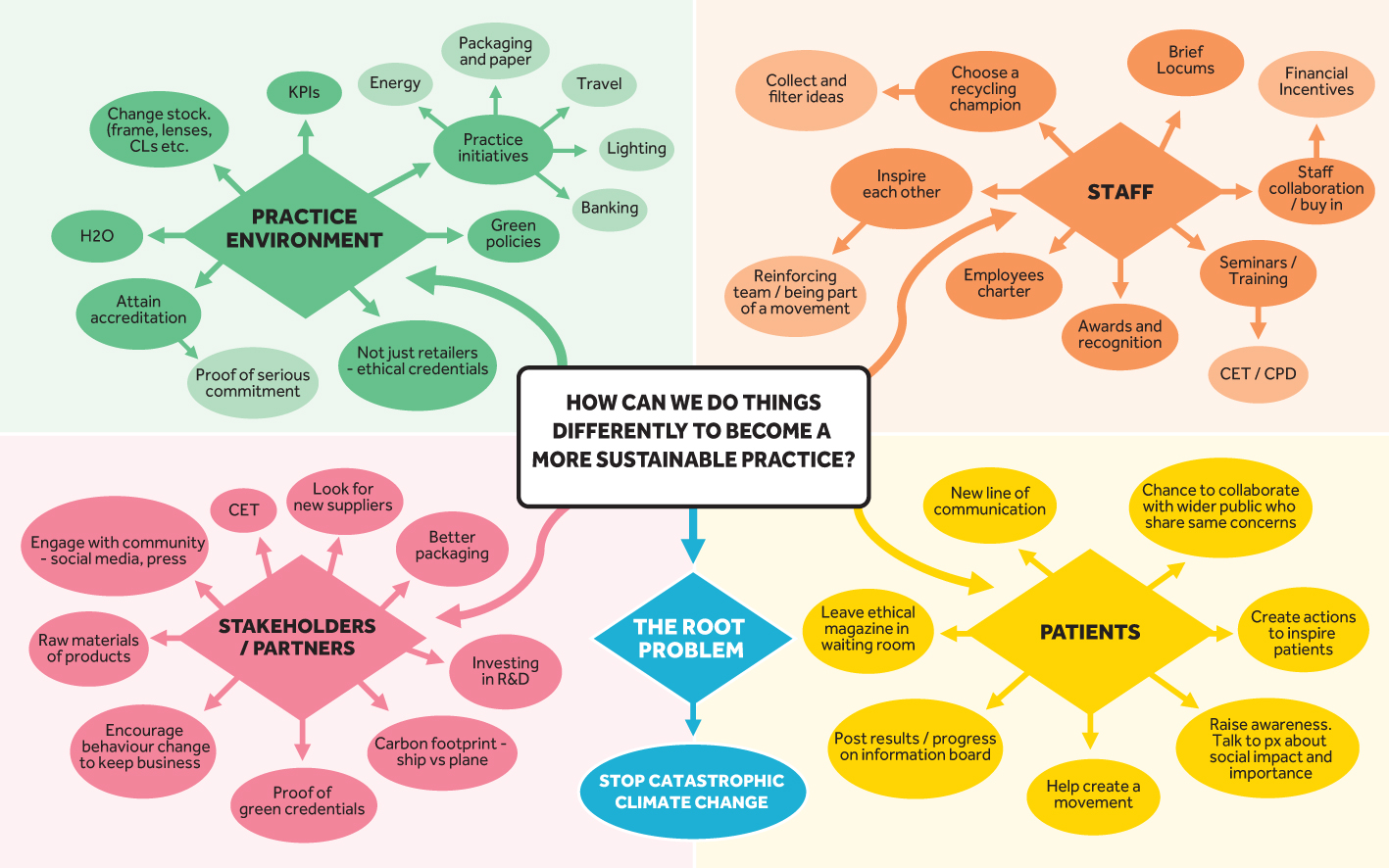
Figure 1. Chris’s Mind Map
Green’s Opticians is independent and has been in the town of Digbury for more than 50 years. For the last 15 years, it has been under the ownership of Chris, a dispensing optician. There are five other members of staff supporting Chris: a full-time independent prescriber (IP) qualified optometrist; an ABDO qualified optical assistant (OA) (dispensing, repairs, adjustments); a practice administrator (reception duties and social media person); a practice technician (OA, adjustments and repairs); a locum contact lens optician (CLO) who comes into the practice for two half days a week; and Chris.
It is a middle to high-end practice catering for all the family – although promotion of paediatric activity is low key. Green’s is a professional environment where the average dispensing value is high and patients receive two appointments when they book an eye examination: a 30-minute eye examination appointment followed by a 30-minute dispensing appointment.
There are not many spectacle frames on display, just enough to be interesting. Most frames are in drawers and after a discussion of what the patient desires in the way of aesthetics, and what the dispensing optician (DO) thinks is be the appropriate support for the lenses, the patient is offered a selection. This will lead to a discussion, maybe a second selection and hopefully a choice. The practice has a relaxed vintage drawing room vibe and is designed to be welcoming to everyone.
Looking to new challenges and goals
Thanks to consistent hard work, business has been healthy and steady for the practice. However, steady is not good enough for Chris who, like many others during the Covid crisis, began to reflect and explore areas to diversify and differentiate herself from the competition.
There is another independent opticians in town, which is less progressive, and a Specsavers practice. Chris is mother to two teenage children and a lover of the outdoors, so the threat to the planet from greenhouse gases and human insouciance has been a regular topic in family discussions. The regular and shocking images beamed around the world of floods, storms destruction, famines and fires, are stark reminders to Chris and her family to get involved.
It is because of the climate crisis that Chris decided to look at the possibility of making her practice more sustainable, and use this as a promotional tool and USP. If nothing else, it would give her and her staff a challenge to find something new and exciting to work towards.
Hatching a plan from scratch
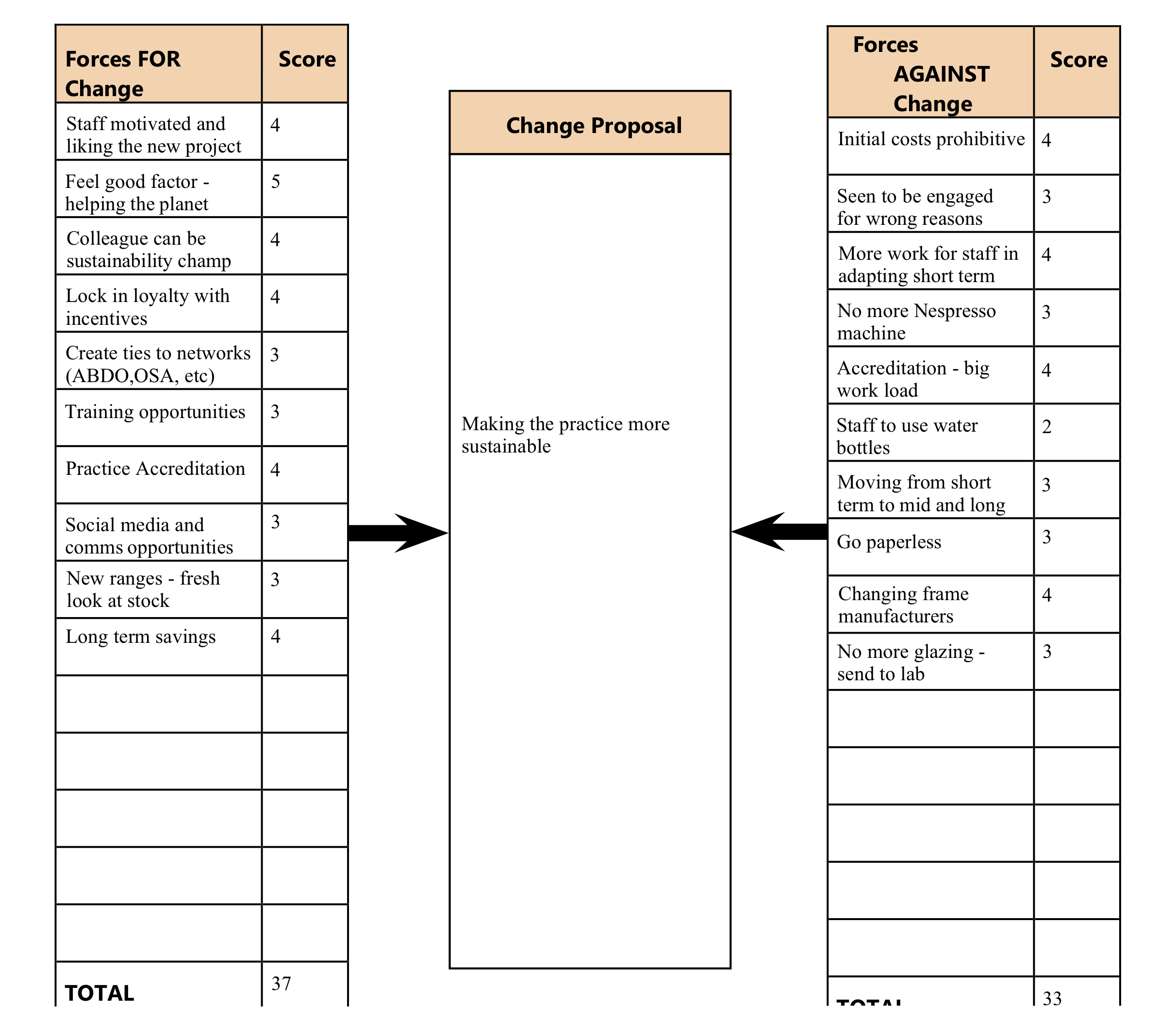
Figure 2. Chris’s Force Field Analysis
Not everyone in business can be an expert in project planning but to initiate a transformation, Chris understood that she needed a plan in place to guide any process – from inception to completion. This would be the spine of her project: a blank (recycled) piece of paper was the first thing to be employed.
So, what could this new venture look like? A good to visualise this was to draw a Mind Map1 and think about what would be involved. A Mind Map is a graphical technique to improve creative thinking and knowledge attainment, utilising colours, images, codes and dimensions to amplify and enhance key ideas.
To create her Mind Map (Figure 1), Chris sat and came up with this key question for her analysis: how can we do things differently to become a more sustainable practice? She decided there would be a number of elements that would be affected by this transformation: staff, patients, stakeholders/partners and the practice environment. All of these would be linked by the root problem of the catastrophic effects of climate change, and the desire to play a part in its reduction.
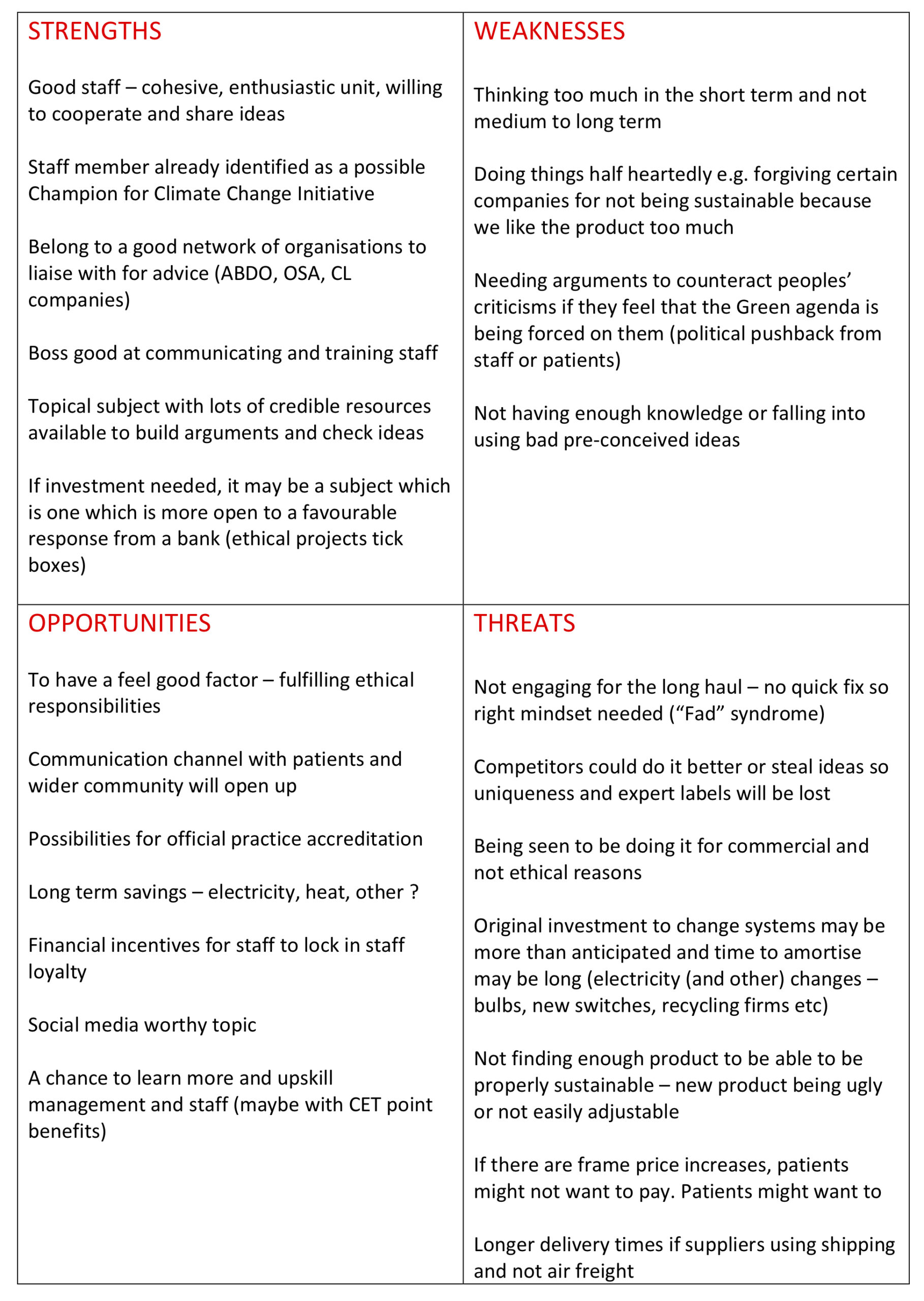
Figure 3. Chris’s SWOT Analysis
To further explore if her plan was worth pursuing, Chris employed a Force Field Analysis (Figure 2) to explore the weight of pros and cons for her burgeoning project. This was followed by a SWOT analysis (Figure 3), allowing her to think more deeply about the strengths, weaknesses, opportunities and threats of the idea.
Once she had completed these steps, Chris was reassured to see that her plan seemed worth exploring in more detail. She found that a good way to think about the transformation was to pretend that she was explaining what she wanted to do, and her involvement, to a potential investor such as a bank or new partner.
Chris found inspiration from a website called Kickstarter, which looks at the journeys of artists looking for funding and support. There she found a list of useful questions recommended to shape any potential pitch she might make, and this made her think more critically about her idea.
The questions helped to dissect ideas such as what she was planning to do, where the project originated and its history, describing a plan or schedule for the scheme, risks and challenges, budgetary considerations, reasons for caring and passion to commit to the project. Taking time to be analytical at this stage, helped her separate a whim from a solid idea.
Researching opinions and guidance
In addition to these assessments, it was deemed judicious to research opinions and guidance from optical bodies on the subject of sustainability. Chris found the most helpful of these to be the ABDO website with details of their SEE Summit and the #thinkinggreen initiative. As a result of further exploration on the ABDO website, it was possible to look at a number of case studies from other practitioners who had decided to add sustainability actions to their business profile, and to learn from their experiences.
Chris also found that the European Council of Optometry and Optics had published documents on sustainability, and their intention to pursue this as an important topic for the optical sector.
An additional valuable resource regarding best practice was a Powerpoint CPD presentation given by optometrist, Simon Berry. Simon transformed his practice into a sustainable business and was ahead of the curve in taking the decision to become eco-friendly. Learning from his experience was a great help.
Surveying key stakeholders
The inspiration derived from the different resources, led Chris to produce three questionnaires to assess the attitudes of key stakeholders towards her plan. The three main stakeholders identified were patients (customers), staff (those undertaking the transformation) and suppliers (those who would be directly impacted by the new commercial direction and would choose, or not, to collaborate in a sustainable way.
The questionnaires were programmed to be sent out at different times with the collection and analysis of results being more immediate for the staff and suppliers, but more long-term and sustained for patients. Chris also devised a Gantt Chart to add structure to the project plans.
The purpose of a Gantt Chart is to clarify and simplify project management by allowing the scheduling and tracking of the project’s progress. There are many different websites offering specific tools, more or less complicated in structure. Chris devised her own Gant Chart using an Excel spreadsheet, which was an inexpensive and simple way to get the desired result.
Even in its simplest form, a Gantt Chart gives a view of areas where there are stumbling blocks allowing the project manager to assess if these blocks will seriously delay the project or if alternative actions should be added to the plan. The chart can be thought of as a roadmap where there is a journey schedule created for reaching the final destination. If there are delays, alternative routes can be found and added into the itinerary.
Brainstorming with staff
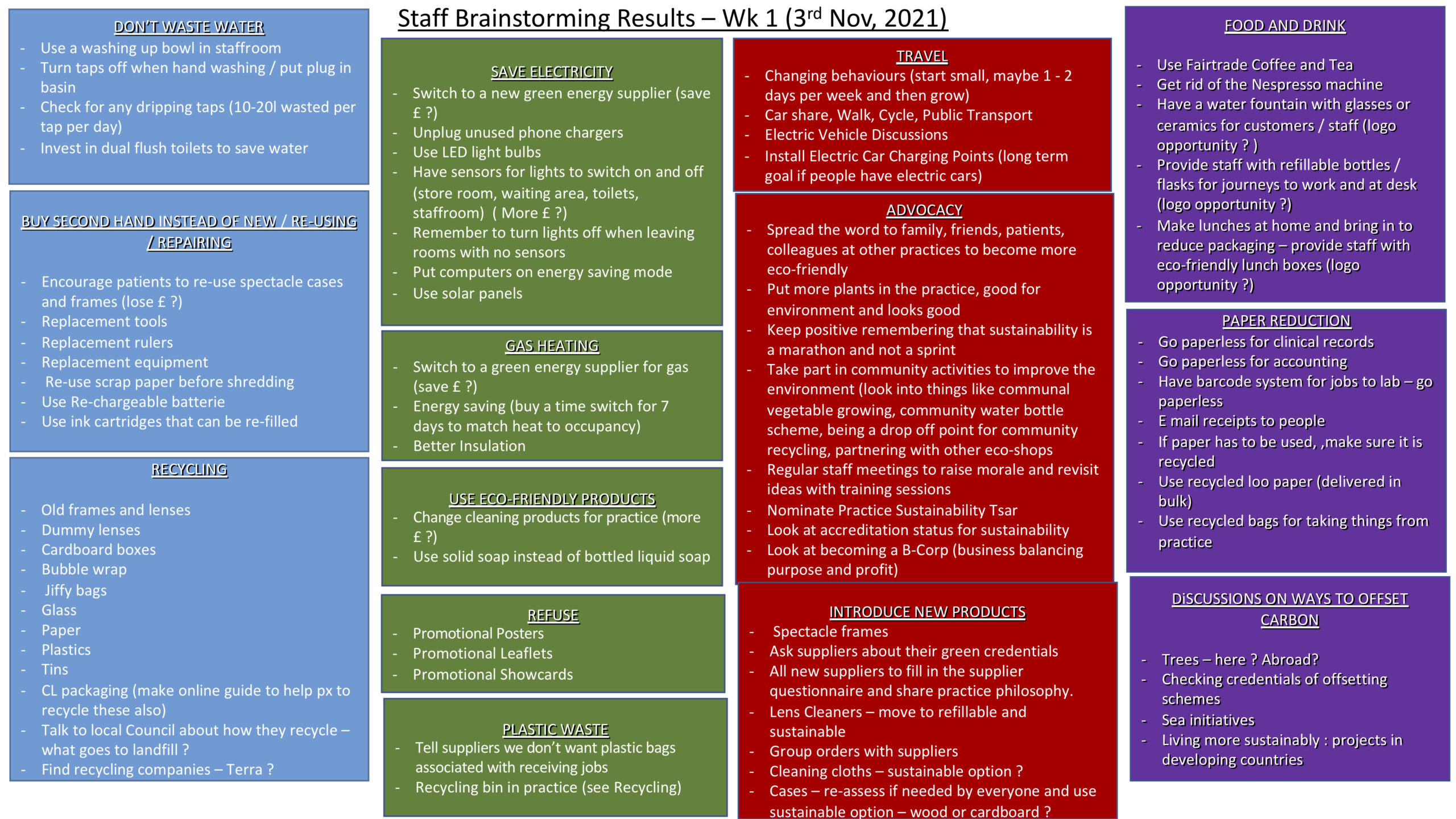
Figure 4. Results form practice brainstorming session
Feeding into the Gantt chart were results from a staff brainstorming session (Figure 4). This task was undertaken early in the project planning since Chris had identified that gathering opinions from her trusted team members was a key element to the success of the project.
Giving staff members the opportunity to be nominated as sustainability lead for the practice also demonstrated Chris’s commitment to the cause and willingness to promote ambition and support the successful candidate with training and extra responsibility. The creation of this position was also identified as a critical success factor to help ensure consistency and longevity for Chris’s transformation plan. Having the sustainability lead shine as an enthusiastic role model would boost the collective efforts of staff members and motivate them to implement the new strategic goals.
Long-term investment
It was clear from the outset that a danger for the business would be paying lip service to the notion of sustainability by not adequately investing the time or commitment properly. For instance, only having a range of eco-friendly frames in a practice, does not a sustainable practice make.
Chris discovered that promoting sustainability as a key axis of business development was not without risk, with studies showing that although awareness and engagement of environmental issues were growing, consumers were increasingly skeptical of green promises by businesses2.
One key component of the transformation plan was to understand the concept of carbon neutrality and how to work towards making the practice carbon neutral. As this was a totally new discipline for Chris, she enrolled on a course with Futurelearn, an online education provider. The course was titled, ‘How to measure, reduce and offset your company’s carbon footprint’, and not only introduced her to key terminology – it taught her about carbon footprint modelling and how to fill in a carbon footprint calculator for her business.
Apart from being a free course, Chris appreciated the way it was broken up into bite size chunks, ideal for digesting new information, and could easily fit into her busy lifestyle. Once the practice’s sustainability lead was chosen, they too were encouraged to undertake this course.
Cultivating a cumulative effect
Optical practices have a small influence on global warming but worldwide, there are many making the cumulative effect of action more attractive. Their eco-credentials can influence waste disposal, unsustainable waste, pollution and depletion of the ozone layer by changing behaviours.
Some of these behaviours will be looking at stock, how much energy is used and what type of energy, staff engagement, interaction with stakeholders and community, waste schemes and other consumables used by the business. Stocking products is an endorsement of those products, so if they are not eco-friendly, or from a supplier who is demonstrably improving their eco-credentials, it reflects poorly on a sustainable business.
Chris became aware that there were no completely sustainable products available, as every product has some sort of environmental impact. However, she bought into the idea of trade-offs, realising that there had to be a compromise as to whether any product stocked would represent a tangible benefit for the business versus any potential damage the product made to the environment.
This became tricky to measure since Chris found that it was very difficult to gain access to all the manufacturing and distribution data from suppliers regarding the life cycles of lenses, frames and contact lenses. Chris also realised that some of her industry partners did not know the full story concerning the origins of their products or component parts.
It was, therefore, difficult in some cases for Chris to check ethical claims. This made her gravitate towards companies that were the most transparent and truthful. If improvements were seen to be being made and could be identified, then this was a plus, demonstrating that everyone seemed to be making the sustainability journey together but at different stages.
Professional standards of practice and ethics were also high on Chris’s list of considerations, with honesty (duty of candour) being a standard, which opticians are held to.
Making informed decisions
There are many claims and messages in the marketplace, ranging from energy efficiency to packaging choices, from sustainable development to which materials are used, and many more. In a confusing landscape, Chris was forced to make intelligent ‘guestimates’ and these became more intelligent as she gained extra knowledge.
Her personal choice and issues which were particularly important to her also influenced these decisions. This is where her three questionnaires became helpful. Simon Berry, the optometrist that Chris listened to in the ABDO CPD lecture, had much more experience of collating data from questionnaires and comparing viewpoints between consumers, professionals and suppliers. Interestingly, he found that there were some key differences in opinion which, if ignored, could undermine the success of his project. This underlined the importance of avoiding guesswork regarding patient opinions.
One hypothesis seems to be that consumers are growing and shaping market preferences with sustainability increasingly seen as giving competitive advantage3. Not every industry seems to have embraced the sustainability message to the same degree, for example, the fashion industry with the ‘fast fashion’ trend.
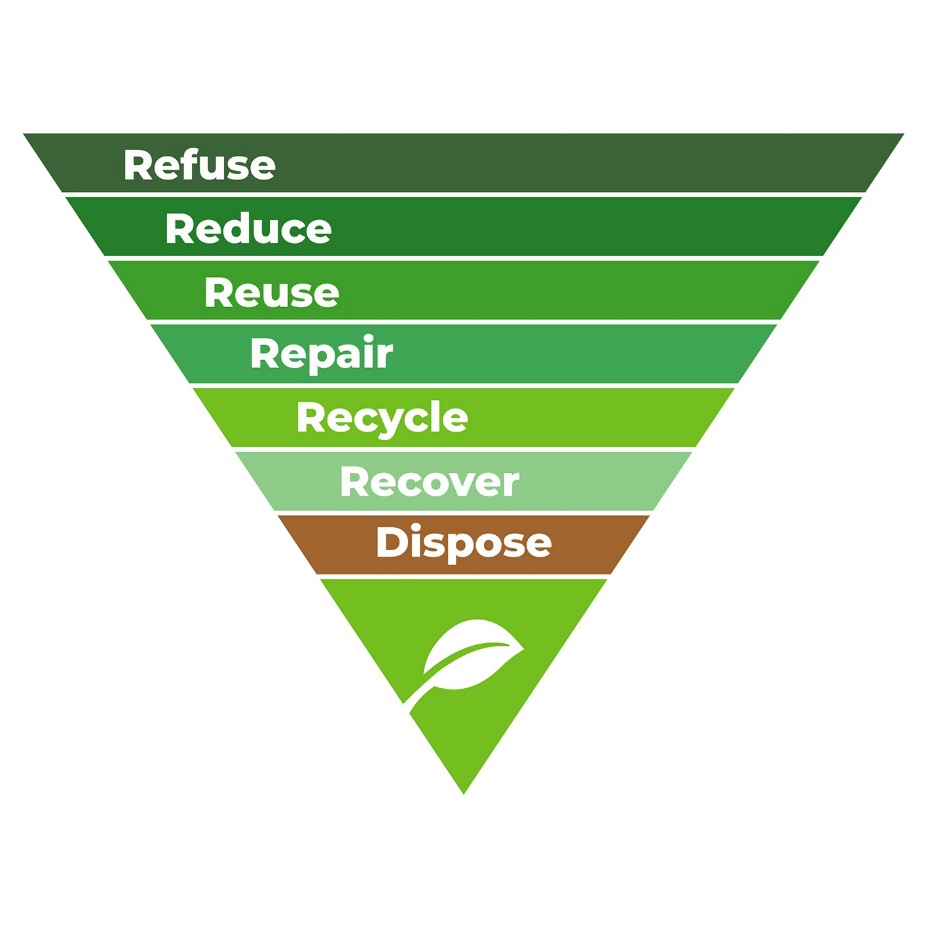
Figure 5. ABDO’s #thinkinggreen pyramid
One encouraging sign seems to be the increasing popularity of vintage fashion, with vintage clothing sales gradually increasing4. Chris had read around the subject of recycling and reusing motivated by ABDO’s triangle infographic (Figure 5). She had found that the trend to recycle and reuse was connected to people wanting to save money, be unique, tap into a craving for nostalgia and also a desire to save the planet.
She noted that this was something that could be capitalised on in her practice, with the re-using of old frames (maybe as a second pair instead of offering a cheap alternative from China) or offering to copy a beloved frame (reducing stock), taking bespoke measurements and showing off her optician’s skills. The frame could then be custom made using 3D printing technology to save on wastage. This same 3D printing technology could also be used to repair old but, otherwise, good frames5.
Avoiding ‘green opportunism’
Chris was aware of the risks of promoting sustainability as a key axis of her business development. Studies she had read showed that although awareness and engagement of environmental issues were growing, consumers were increasingly skeptical of green promises by businesses, fearing that they might be ‘jumping on a bandwagon’ by being opportunist, trying to gain commercial advantage without any solid efforts behind the claims2.
This is known as ‘green opportunism’ and the false representation designed to mislead consumers is growing and is referred to as ‘greenwashing’6. Chris was aware that credibility through evidence-based practice would be important for any communication (verbal or written) between her staff team and patients.
Green’s Opticians is a professional practice, so any eco-friendly communication would have to reflect genuine environmental marketing strategies for the business to be successful.
Even though there would be some activities that would yield cost savings, it was not immediately obvious how long these savings would take to kick in and if they would be offset with higher costs in other areas (such as new niche frame stocks and contracting specialised waste disposal services).
Chris was not doing this as a cost saving exercise, she was interested in gaining competitive advantage, possible by incorporating non-economic factors, which could help to project a better image of her practice, allowing her to differentiate and reputation build7.
Reading further8, Chris found out about ‘creating shared value’, which stressed that businesses could engage in corporate responsibility and benefit society while still flourishing economically and competitively. She liked this concept, as it fed into her knowledge of corporate social responsibility and engaging with social issues and behaving ethically.
A marathon not a sprint
Chris is still in the throes of implementing her new strategy of moving to a more sustainable business model. It is going to be a marathon and not a sprint but so far, the signs are encouraging. Staff, suppliers and patients all seem to be engaged with this new, worthwhile and exciting way of doing business.
References
1. Aveyard H. Doing A Literature Review In Health And Social Care: A Practical Guide. 4th ed. London: Open University Press. 2019.
2. Pomering A and Johnson LW. Advertising corporate social responsibility initiatives to communicate corporate image: inhibiting scepticism to enhance persuasion. Corporate Communications: An International Journal 2009;14:420-439.
3. Zabkar V and Hosta M. Willingness to act and environmentally conscious consumer behaviour: can prosocial status perceptions help overcome the gap? International Journal of Consumer Behaviour 2012 37;3:257-264.
4. Cassidy TD and Bennett HR. The rise of vintage fashion and the consumer vintage consumer. Fashion Practice 2021 4;2:239-262.
5. Barrow R. Embracing the future. Vision Now November 2021: 22.
6. Parguel B et al. How sustainability ratings might deter ‘greenwashing’: a closer look at ethical corporate communication. Journal of Business Ethics 2011;102:15-28.
7. Porter ME and Kramer MR. Strategy and society: the link between competitive advantage and corporate social responsibility. Harvard Business Review 2006; 84(12):78-92.
8. Porter ME and Kramer MR. Creating shared value. Harvard Business Review 2011;89:62-77.
If you are interested in a more sustainable practice, follow Chris’s example. You could do a Mind Map, Force Field Analysis and/or a SWOT Analysis (see the ABDO Business Support Hub), explore the ABDO SEE Hub or complete the sustainability CPD.
Elaine Grisdale FBDO FAAO is ABDO head of professional services and international development.